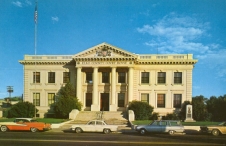Douglas County Courthouse
Created in 1861, Douglas County was named after failed presidential candidate Stephen A. Douglas, chairman of the Senate Committee of Territories at the time. The state legislature selected Genoa as the location for the county seat.
Early accounts describe the county's first courthouse as a converted livery stable with a ladder serving as its front steps. In 1864, officials authorized a property tax to finance a more substantial structure at a cost not to exceed $20,000. They appointed T.J. Furbee to design the courthouse, and hired builders Lawrence Gilman and L.C. Chapman. During construction, Gilman severed his partnership with Chapman and finished the project with Rufus Adams.
Completed in 1865, the two-story brick courthouse with Greek Revival elements contained room for offices, a jail, and a second floor courtroom. It measured 66-by-36-feet, with a 12-foot high ceiling on the first floor, and a 14-foot high ceiling on the second. The vertical nature of the courthouse enhanced its monumental appearance. Fire destroyed much of the building in 1910, and restoration of the structure cost $18,000.
In 1916, the seat of government moved to Minden. The county employed Frederick DeLongchamps and George L.F. O'Brien to design a courthouse for $700. Contractors Friedhoff and Hoeffel completed the building in 1916 for $25,000.
Located in the residential district, the single-story, Neoclassical structure exhibits a dentil cornice with full entablature under a low-brick parapet and concrete cap. Four columns support a recessed entry. The interior hallways are decorated with black marble wainscoting. Doors of glass and wood open to the courtroom.
Two more structures were added to the courthouse over the years. DeLongchamps designed the first in 1956, and Ferris, Erskine, and Calef built the second in 1964 at a cost of $174,245.
Article Locations
Related Articles
Further Reading
None at this time.


